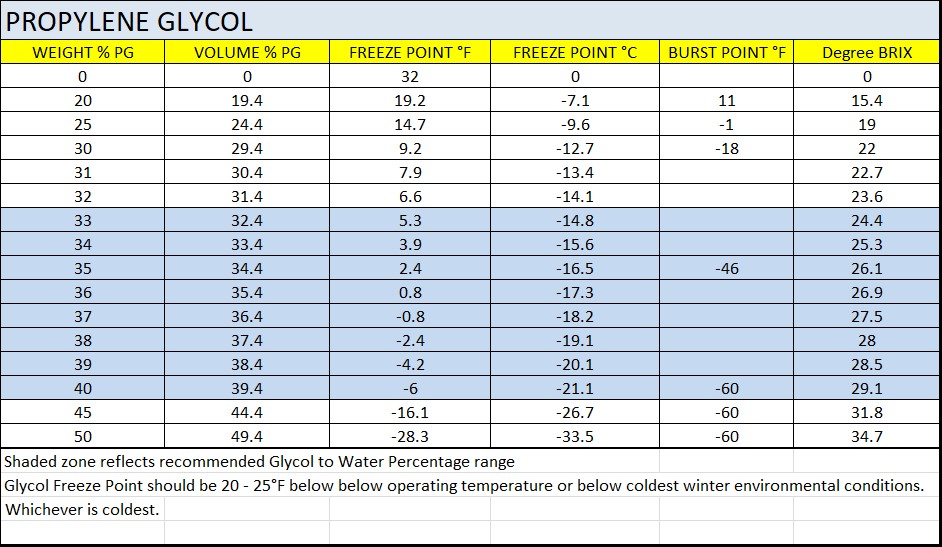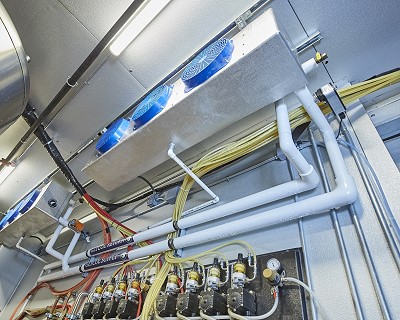The following article was originally published on April 24, 2014. It has been reviewed and updated as necessary by the ProBrewer editorial staff.
Other related resources on ProBrewer: Refrigeration Glossary of Terms and Chiller Troubleshooting 101
Just to be clear. Ethylene Glycol is toxic and cannot be used because of potential contact with food product.
WHAT’S PROPYLENE GLYCOL?
To put it simply, its food grade antifreeze. When a commercial food product is being cooled, designated food grade antifreeze is required. The glycol, diluted with water, enables your chiller system to maintain the 25-27 °F temperature range that a brewery requires.
WHAT TYPE OF PROPYLENE GLYCOL CAN I USE?
Manufacturers recommend USP grade propylene glycol. United States Pharmacopeia (USP) is the official standard for medicine, supplements, and health care products in the United States. Glycol displaying a USP grade assures the product is the highest quality and approved for food applications.
Beware of inexpensive, low quality, propylene glycol-based solutions available in the marketplace. Technical grade or RV rated non-toxic antifreeze, is not designed for the demands of a brewery recirculation system and could breakdown quickly, resulting in expensive equipment failure due to freezing and/or gumming up the systems heat exchangers.
If your system has galvanized (steel), black iron, or other ferrous metal components, a rust inhibitor will be needed in the solution. Many food grade propylene glycol products include inhibitors. Find out by checking the SDS (Safety Data Sheet) for the glycol you intend to use.
DETERMINING THE PERCENTAGE PROPYLENE GLYCOL MY SYSTEM NEEDS
Many brewery operators don’t understand why so much glycol is needed in their chiller system. They assume that if the chiller system is at +27 °F glycol, the freezing point of the solution only needs to be below +27 °F. But you must keep in mind the temperature of the refrigerant will be 10 – 15 °F below the temperature of the glycol solution. So, if you’re operating with a +27 glycol Temperature, your refrigerant temperature is about +12 to +17 °F. The recommended freezing level of your glycol/water solution should be 20-25 °F. below your chiller system set point.
Example:
Chiller Setpoint: +27°F
Glycol Freeze Level: + 7°F – +2°F
Ensure your glycol burst protection level is significantly lower than your lowest anticipated environmental temperature. What is burst protection? Pure water freezes at 32° F. A mixture of 30% propylene glycol to 70% water has a freeze point of 8°F, but the burst point is -18°F. At this temperature the system will be protected, the coolant will become slushy but able to flow into expansion tank. This is very important for closed loop systems exposed to freezing conditions. Consult the manufacturer of your glycol for specific recommendations, as the “Burst point” rating tends to vary between glycol manufacturers due to the proprietary inhibitors they use. Usually 35-40% inhibited propylene glycol is sufficient in all but the very coldest climates. Operating with a 35% glycol to 65% water Solution typically will protect from freeze up to +1 °F.*
*The proper propylene glycol to water ratio mixture is very important in your chiller system. Too little glycol can lead to a costly freeze up. Too much glycol inhibits system efficiency.
OK, I’VE DETERMINED WHAT MY PERCENTAGE SHOULD BE, HOW DO I FIGURE OUT HOW MUCH GLYCOL I’LL NEED FOR MY SYSTEM?
First, you’ll need to determine the systems total volume.
1) Figure out the estimated capacity of your systems piping. (Your plumbing contractor or pipe supplier can help you, or simply take the length measurements and the inside diameter of the pipe and plug them into an online “Pipe Volume Calculator”.
2) Add to this, the volume held by your tank jackets (Tank manufacturer should have this number).
3) Finally, add the capacity of your chiller system reservoir to get you total system volume. (Chiller system tank capacity will be available from the manufacturer.)
In today’s wonderful world of internet access, many glycol providers have an online “Glycol Addition Calculator” specific to their product.
The basic formula is G = (%D-%P)/100-%P
V – KNOWN SYSTEM VOLUME
%D – DESIRED GLYCOL CONCENTRATION (%)
%P – PRESENT GLYCOL CONCENTRATION (%)
G – APPROXIMATE NUMBER OF GALLONS NEEDED
DETERMINING GLYCOL SOLUTION PERCENTAGE (FREEZE POINT) OF AN EXISTING SYSTEM
The easiest way is by measuring the solution using a glycol refractometer which will provide a reading in degrees Brix. A 35% Inhibited Propylene Glycol to 65% water solution comes to (24.75 brix). Tutorial
If you don’t have access to a refractometer, and you have some time, many glycol manufacturers will test the freeze point/concentration of solution samples sent to them.

COMMON TYPES OF GLYCOL PIPING USED IN BREWERIES
Glycol Piping Choices:

Copper
Copper pipe is a great option for your glycol piping. Although materials and installation can be higher costed than other options, it is rigid pipe that will provide years of trouble free service.
Pre-Insulated Schedule 80 PVC
A great economical option, Schedule 80 PVC when installed correctly performs well in breweries. We strongly discourage piping your tanks with PVC. However, up high as a rigid pre-insulated mainline, it works great. Steer clear of Schedule 40 PVC.
ABS Plastic Piping
ABS is similar to PVC. It is available pre-insulated. Although costly, this option is engineered specifically for chilled water applications making it a preferred product for many breweries.
Cross-Linked Polyethylene (PEX)
Typically not used as a glycol mainline, PEX is a very economical and easy to install option for tank piping.
Nylon Braided Rubber Hose
A light duty hydraulic hose used as a transition from an ABS or Schedule 80 PVC mainline to copper tank piping. Also used as an economical tank piping solution.
There are many glycol piping systems on the market these days. Whatever you decide, we recommend insulating it fully. Polyurethane foam or dense closed cell foam are preferred. Do not use boiler pipe fiberglass insulation. Exterior piping should be insulated well and then cladded.
GLYCOL LINE LAYOUT
Here are several factors you should consider in designing and laying out your glycol system.
1. Position your chiller system as close to the tanks as possible. You want as little restriction between the chiller system and tanks as possible.
2. Do not use too many pipe fittings or undersized piping because that will cause increased Glycol Line pressure and possibly compromise the cooling jackets on your tanks.
3. Use the “FIRST IN / LAST OUT” Piping method. The FIRST Fermenter on the SUPPLY Header, should be the LAST Tank on the RETURN Header. Please see illustration below. This balances system flow, and ensures equal flow distribution to each tank in the system.

4. Install pressure (0-50 PSI) and temperature (0-50 °F) gauges in the SUPPLY header. Place them in a high visibility location. These gauges can alert you to a cooling system problem and/or a pressure problem.
5. Confirm with your chiller manufacturer if the unit has an onboard bypass valve. If not, install one in the piping system. A manual ball valve at the end of the supply line that ties into the return is also recommended. This ball valve should be barely cracked open a hair, allowing a trickle of glycol through the system at all times. Another more expensive option would be to install an additional bypass valve in the piping system, set at the appropriate pressure to allow the glycol/water to barely flow through.
6. It’s highly recommended that a Y-Strainer with a 20-mesh screen be included in on your glycol system return line to prevent contaminants from reaching your chiller. The Y-strainer should have a minimum size of ½” larger than your glycol mainline size. Y-Strainer Tutorial
7. Each fermenter should have a dedicated chilled water solenoid valve controlled by a temperature control that senses the product temperature. When your product temperature drops to the set point temperature the solenoid valve will close shutting off the flow of glycol.